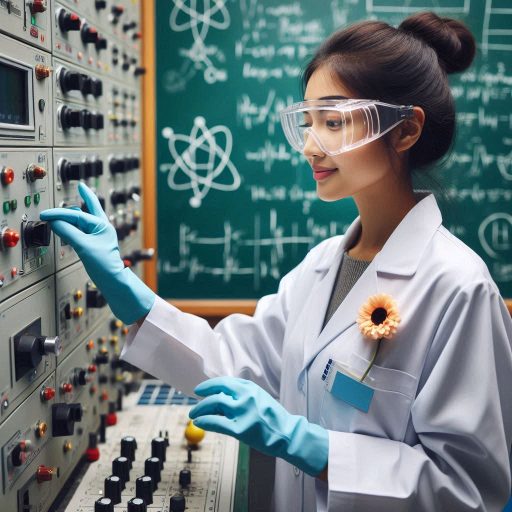Introduction
Collaboration and teamwork are essential among nuclear scientists.
Nuclear science plays a vital role in energy production, medicine, and environmental protection.
These professionals work together to solve complex problems and advance research.
Nuclear science encompasses the study of atomic nuclei and their interactions.
It provides critical insights that drive innovations in various industries.
For instance, nuclear technology is instrumental in developing clean energy solutions and medical treatments.
Effective teamwork enhances the efficiency of research projects and accelerates discoveries.
Nuclear scientists bring diverse skills and perspectives, leading to more comprehensive solutions.
Collaboration fosters an environment where ideas can flourish and challenges can be addressed collectively.
In addition, partnerships between scientists and organizations strengthen research efforts.
Collaborative projects often attract funding and resources, making research initiatives more successful.
Teamwork also encourages mentorship, allowing experienced scientists to guide newcomers in the field.
Ultimately, the collaborative nature of nuclear science leads to significant advancements.
By working together, nuclear scientists can address pressing global challenges, such as climate change and health issues.
Their collective efforts help ensure a safer and more sustainable future for society.
Definition of Collaboration in the Context of Nuclear Science
How Collaboration Enhances Research Outcomes and Innovation
Collaboration among nuclear scientists significantly enhances research outcomes.
When scientists work together, they pool their expertise and resources.
This collective knowledge fosters innovation and accelerates the pace of discovery.
Diverse perspectives lead to more comprehensive solutions to complex problems.
Teamwork also encourages the sharing of best practices.
Scientists learn from each other’s experiences and techniques.
This exchange of ideas often leads to breakthroughs that single researchers might not achieve.
Collaborative efforts promote a culture of creativity, pushing the boundaries of what is possible.
Moreover, collaboration allows for resource optimization.
Different institutions can share equipment and facilities, reducing costs and increasing efficiency.
By working together, scientists can tackle larger projects that require extensive resources.
This synergy ultimately leads to more impactful research outcomes.
Additionally, collaboration facilitates international partnerships.
Nuclear science often addresses global challenges like climate change and energy security.
By joining forces, scientists can develop innovative solutions that benefit multiple countries.
Collaborative projects also enhance the global scientific community, fostering goodwill and understanding among nations.
Successful Collaborations Among Nuclear Scientists
Numerous successful collaborations illustrate the power of teamwork in nuclear science.
One notable example is the International Thermonuclear Experimental Reactor (ITER) project.
This massive international collaboration aims to demonstrate nuclear fusion as a viable energy source.
Scientists from 35 countries work together on this ambitious project, sharing expertise and resources.
Another example is the Large Hadron Collider (LHC) at CERN.
This groundbreaking facility brings together physicists from around the world.
They collaborate on experiments that explore fundamental questions about matter and the universe.
The LHC has produced significant discoveries, including the Higgs boson, thanks to the combined efforts of international teams.
In the field of radiation therapy, institutions like the MD Anderson Cancer Center collaborate with nuclear scientists globally.
These partnerships develop advanced cancer treatments, improving patient outcomes.
By sharing research findings and clinical practices, these teams create innovative approaches to combat cancer.
The Global Nuclear Safety and Security Network (GNSSN) is another excellent example of international collaboration.
This initiative promotes safety and security in nuclear energy through knowledge sharing.
Scientists and regulators from different countries work together to address common challenges.
This collaboration enhances safety standards and strengthens global nuclear governance.
Collaboration among nuclear scientists is essential for enhancing research outcomes and fostering innovation.
By working together, scientists can leverage their collective expertise and resources.
Successful examples, such as ITER and the LHC, demonstrate the significant benefits of teamwork.
These collaborations not only advance scientific knowledge but also promote international cooperation.
By addressing global challenges, nuclear scientists can create impactful solutions that benefit society.
Emphasizing collaboration in nuclear science paves the way for a brighter, more innovative future.
Read: Challenges and Rewards: The Dual Life of an U.S. Environmental Scientist
The role of teamwork in nuclear science
Teamwork Fosters Efficiency, Creativity, and Problem-Solving
Collaboration is vital in nuclear science research.
Teamwork fosters efficiency by distributing tasks among members.
This division of labor accelerates project timelines and enhances productivity.
When researchers work together, they can tackle complex problems more effectively.
Teamwork also sparks creativity.
Diverse perspectives lead to innovative ideas and solutions.
Each team member brings unique expertise and viewpoints to the table.
This variety enriches discussions and inspires out-of-the-box thinking.
Problem-solving improves significantly in collaborative environments.
Teams can brainstorm solutions to challenges that arise during research.
By leveraging the collective knowledge and experience of the group, researchers can identify effective strategies quickly.
Moreover, teamwork creates a supportive atmosphere.
Team members encourage each other and share responsibilities.
This support helps individuals feel more confident in their contributions.
As a result, they are more likely to take risks and explore new ideas.
Effective communication is essential for successful teamwork.
Researchers must share information openly and honestly.
This transparency ensures that all members are on the same page.
It also helps prevent misunderstandings that can hinder progress.
In summary, teamwork enhances efficiency, creativity, and problem-solving in nuclear science research.
Collaborative environments encourage researchers to work together toward common goals, leading to groundbreaking discoveries.
Benefits of Interdisciplinary Teamwork in Nuclear Science Research
Interdisciplinary teamwork offers significant advantages in nuclear science.
Collaborating across disciplines brings together diverse knowledge and skills.
This diversity enhances the research process and fosters comprehensive solutions.
For example, combining expertise from physics, engineering, and biology can lead to innovative approaches.
Physicists may develop new detection methods, while engineers design advanced instruments.
Biologists can provide insights into the biological impacts of radiation.
Together, they create a holistic understanding of nuclear science challenges.
Interdisciplinary teams also improve research quality.
By integrating different perspectives, these teams can identify gaps in knowledge.
They can address these gaps effectively through targeted research efforts.
This collaborative approach leads to more robust findings and conclusions.
Additionally, interdisciplinary collaboration opens doors to new funding opportunities.
Grant organizations often favor research that addresses complex, multifaceted problems.
By demonstrating a collaborative approach, researchers can secure funding for innovative projects.
Furthermore, interdisciplinary teamwork enhances career development.
Researchers gain exposure to various fields and learn new skills.
This broadens their expertise and makes them more versatile in their careers.
Collaborative experiences can also lead to networking opportunities that benefit future projects.
Finally, interdisciplinary collaboration fosters innovation.
Researchers can share ideas and techniques from their respective fields.
This cross-pollination of concepts often leads to breakthroughs that might not occur within a single discipline.
In the end, collaboration and teamwork are essential in nuclear science research.
Teamwork fosters efficiency, creativity, and problem-solving, allowing researchers to tackle complex challenges effectively.
Interdisciplinary teamwork further enhances research quality by integrating diverse knowledge and skills.
As researchers continue to collaborate across disciplines, they will drive innovation and advance the field of nuclear science.
Embracing teamwork not only leads to groundbreaking discoveries but also enriches the careers of those involved.
By fostering a collaborative culture, nuclear scientists can continue to make significant contributions to science and society.
Read: Job Market Trends: Future of Chemistry Jobs in America
Challenges and Barriers to Collaboration and Teamwork in Nuclear Science
Common Issues in Nuclear Science Collaboration
Collaboration is vital in nuclear science, yet teams often face significant challenges.
Communication breakdowns frequently occur, leading to misunderstandings and errors.
When team members do not share information effectively, confusion can arise.
This breakdown can derail projects and delay crucial research.
Competing priorities also hinder effective teamwork.
Different team members may have various objectives or deadlines.
These conflicting priorities can create tension and disrupt collaboration.
When team members prioritize personal goals over team objectives, progress slows.
Additionally, a lack of trust among team members can undermine collaboration.
When individuals do not trust each other’s expertise or intentions, communication suffers.
This distrust can lead to isolation and reluctance to share ideas.
Consequently, the team’s overall effectiveness diminishes, impacting research outcomes.
Strategies to Overcome Collaboration Challenges
Addressing these challenges requires proactive strategies to enhance communication and teamwork.
First, establish clear communication channels among team members.
Regular meetings can foster open dialogue and ensure everyone is on the same page.
Use collaborative tools to streamline information sharing and project updates.
Second, prioritize team goals over individual objectives.
Encourage team members to align their work with the group’s overall mission.
By emphasizing shared objectives, you create a sense of unity.
This alignment fosters a collaborative spirit and enhances team cohesion.
Third, build trust within the team through transparency.
Encourage open discussions about challenges and successes.
When team members feel safe sharing ideas, trust develops.
A culture of transparency empowers individuals to contribute fully, increasing overall team effectiveness.
Additionally, promote team-building activities to strengthen relationships.
Engage in workshops, retreats, or social events to foster camaraderie.
These activities help team members connect on a personal level, enhancing collaboration.
Recognize and celebrate team achievements, no matter how small.
Acknowledging contributions boosts morale and reinforces a positive team environment.
When team members feel valued, they are more likely to engage actively in collaborative efforts.
The Role of Leadership in Promoting Collaboration
Strong leadership plays a crucial role in fostering effective collaboration.
Leaders should model collaborative behavior and set clear expectations for teamwork.
They must encourage open communication and create an environment where everyone feels valued.
Training programs can also equip team members with necessary collaboration skills.
Workshops on effective communication, conflict resolution, and team dynamics enhance teamwork.
By investing in professional development, organizations can improve collaboration among nuclear scientists.
Moreover, leaders should be attentive to team dynamics and address issues promptly.
By identifying and resolving conflicts early, leaders can prevent misunderstandings from escalating.
This proactive approach fosters a culture of collaboration and trust.
Most importantly, collaboration in nuclear science faces common challenges, such as communication breakdowns, competing priorities, and lack of trust.
Addressing these issues requires clear communication, alignment of goals, and trust-building strategies.
Leaders play a vital role in promoting effective collaboration among team members.
By fostering a supportive environment and investing in team development, organizations can enhance teamwork.
Ultimately, overcoming these challenges leads to successful research outcomes and advances in nuclear science.
Read: Challenges and Rewards: Navigating the Chemist Career Path

Impact of collaborative efforts in nuclear science on global challenges
Collaboration Leading to Advancements in Nuclear Energy
Collaboration among nuclear scientists has driven significant advancements in nuclear energy.
Researchers from various disciplines work together to improve reactor designs.
This teamwork enhances safety, efficiency, and sustainability in energy production.
International collaborations, like the ITER project, focus on nuclear fusion.
Scientists from around the world unite to develop this groundbreaking technology.
Fusion promises a cleaner, nearly limitless energy source.
By sharing knowledge and resources, these scientists tackle complex challenges collectively.
Furthermore, interdisciplinary collaborations bring together experts from engineering, physics, and environmental science.
This cooperation fosters innovation in nuclear reactor technology.
Together, they develop advanced materials that can withstand extreme conditions.
These improvements increase reactor performance and safety.
Advancements in Nuclear Medicine through Collaboration
Nuclear scientists also collaborate to advance medical applications of nuclear technology.
They work with healthcare professionals to improve diagnostic and therapeutic techniques.
For example, they develop radiopharmaceuticals used in cancer treatment and imaging.
Collaboration between chemists and nuclear scientists leads to the discovery of new radioactive isotopes.
These isotopes play crucial roles in diagnosing and treating diseases.
This teamwork has transformed cancer care and improved patient outcomes significantly.
Moreover, researchers share data and findings across institutions.
This open exchange accelerates the development of innovative medical solutions.
As a result, collaborative efforts in nuclear medicine continue to evolve, benefiting patients worldwide.
Enhancing Security through Collaborative Efforts
In the realm of nuclear security, collaboration is essential.
Scientists and policymakers work together to address global security challenges.
They develop strategies to prevent nuclear proliferation and ensure safe handling of nuclear materials.
International organizations, like the International Atomic Energy Agency (IAEA), facilitate cooperation.
They promote the sharing of best practices and knowledge among member states.
This collaborative approach strengthens global nuclear security frameworks and enhances safety measures.
Furthermore, researchers engage in joint exercises and training programs.
These initiatives improve preparedness for nuclear incidents and emergencies.
Collaborative efforts foster a culture of safety and vigilance in the nuclear community.
Addressing Environmental Protection through Teamwork
Environmental protection is another area where collaboration proves vital.
Nuclear scientists partner with environmentalists to assess the impact of nuclear technologies.
Together, they develop strategies to minimize waste and ensure responsible disposal.
These collaborative efforts lead to innovative solutions for managing nuclear waste.
For example, researchers work on developing advanced materials for waste storage.
They aim to enhance safety and reduce environmental risks associated with nuclear waste.
Moreover, interdisciplinary teams address the environmental implications of nuclear energy production.
They evaluate the effects on ecosystems and human health.
This comprehensive approach ensures that nuclear technologies are developed responsibly and sustainably.
Future Collaborations Addressing Emerging Issues
Looking ahead, the potential for future collaborations in nuclear science is immense.
Emerging issues, such as climate change and energy sustainability, require collective action.
Scientists must unite to explore innovative nuclear technologies that address these challenges.
Collaboration will be crucial in advancing small modular reactors (SMRs) and advanced nuclear technologies.
These innovations promise to provide clean energy while minimizing environmental impact.
Multidisciplinary teams will play a vital role in developing and deploying these technologies.
Additionally, as the global population grows, nuclear scientists must collaborate to ensure food security.
They can explore nuclear techniques for improving agricultural practices and pest management.
In review, collaboration among nuclear scientists has led to remarkable advancements in energy, medicine, security, and environmental protection.
As challenges evolve, teamwork will remain essential for addressing emerging issues in the field.
By fostering a spirit of collaboration, nuclear scientists can continue to drive innovation and contribute positively to society.
Read: Diverse Career Paths: From Chemist to Patent Attorney in the US
The Role of Leadership in Facilitating Collaboration and teamwork among
Qualities of Effective Leaders in Nuclear Science
Effective leaders play a crucial role in fostering collaboration and teamwork in nuclear science.
They create an environment where every team member feels valued and heard.
Strong communication skills enable leaders to convey ideas clearly and listen actively to others.
Leaders in nuclear science demonstrate adaptability and flexibility.
They navigate challenges and encourage their teams to find innovative solutions.
Such leaders inspire trust and respect among team members.
They promote a culture of open dialogue and constructive feedback.
Visionary leaders set clear goals and expectations.
They align team efforts with the organization’s objectives.
By establishing a shared vision, they motivate team members to work collaboratively.
These leaders celebrate achievements and recognize individual contributions.
Additionally, effective leaders prioritize inclusivity.
They embrace diversity within their teams, recognizing the value of different perspectives.
This approach fosters creativity and enhances problem-solving capabilities.
Inclusive leaders create a sense of belonging, which boosts morale and productivity.
Furthermore, leaders in nuclear science encourage professional development.
They provide opportunities for team members to enhance their skills.
By mentoring and supporting their colleagues, they build a strong, cohesive team.
These leaders understand that investing in their team’s growth benefits the entire organization.
Tips for Aspiring Nuclear Scientists to Develop Leadership Skills
Aspiring nuclear scientists can cultivate leadership skills to enhance collaborative research efforts.
First, seek mentorship from experienced professionals in the field.
Learning from their experiences provides valuable insights and guidance.
Next, actively participate in team projects and discussions.
Engaging in collaborative efforts helps develop essential communication and teamwork skills.
Embrace feedback from peers and mentors to improve your performance continuously.
Additionally, take initiative in organizing team meetings or discussions.
Proposing topics or leading brainstorming sessions demonstrates leadership potential.
Such actions show your commitment to fostering collaboration within the team.
Consider participating in professional organizations related to nuclear science.
These groups often provide networking opportunities and workshops on leadership skills.
Engage with fellow members and share ideas to broaden your perspective.
Moreover, develop strong organizational skills.
Effective leaders must manage time and resources efficiently.
Prioritize tasks and set clear deadlines to ensure project success.
Good organization fosters collaboration by keeping team members aligned and focused.
Lastly, practice active listening.
Being attentive to others’ ideas fosters trust and respect within the team.
Encourage team members to share their thoughts and perspectives.
This practice creates a culture where everyone feels valued and motivated to contribute.
In essence, effective leaders possess qualities that foster collaboration and teamwork in nuclear science.
They inspire trust, promote inclusivity, and prioritize professional development.
Aspiring nuclear scientists can develop leadership skills through mentorship, active participation, and effective communication.
By cultivating these qualities and skills, individuals contribute to successful collaborative research efforts.
Embracing teamwork and collaboration in nuclear science leads to innovative solutions and advancements in the field.
Together, scientists can tackle complex challenges and drive progress for a sustainable future.
Conclusion
Collaboration and teamwork are vital for nuclear scientists to tackle complex challenges in their field.
Working together enhances problem-solving abilities and fosters innovative solutions.
Diverse perspectives from team members lead to more comprehensive research and effective decision-making.
Effective communication is key to successful collaboration.
Scientists must share their expertise and findings openly to create a productive environment.
Regular meetings and discussions help ensure that all team members are aligned and informed about ongoing projects.
Collaboration also strengthens the impact of research.
When scientists partner with institutions, industry leaders, and government agencies, they expand their resources and networks.
This synergy often results in groundbreaking discoveries that might not occur in isolation.
Readers should recognize the value of teamwork in advancing nuclear science.
Collaborative efforts can lead to significant advancements in safety protocols, energy efficiency, and environmental protection.
By pooling resources and knowledge, scientists can address global challenges such as climate change and energy security.
Encouraging collaboration not only benefits individual researchers but also enhances the entire field of nuclear science.
As scientists work together, they build a stronger community dedicated to innovation and responsible practices.
Transform Your Career Today
Unlock a personalized career strategy that drives real results. Get tailored advice and a roadmap designed just for you.
Start Now[E-Books for Sale]
The Big Book of 500 High-Paying Jobs in America: Unlock Your Earning Potential
$19.99 • 500 High-Paying Jobs • 330 pages
Explore 500 high-paying jobs in America and learn how to boost your career, earn more, and achieve success!
See All 500 High-Paying Jobs of this E-Book
1001 Professions Without a Degree: High-Paying American Jobs You Can Start Now
$19.99 • 1001 Professions Without a Degree • 174 pages
Discover 1001 high-paying jobs without a degree! Unlock career tips, skills, and success strategies for just $19.99!




